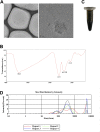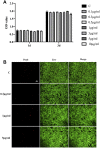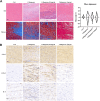Fullerenol inhibits tendinopathy by alleviating inflammation
- PMID: 37064249
- PMCID: PMC10098086
- DOI: 10.3389/fbioe.2023.1171360
Fullerenol inhibits tendinopathy by alleviating inflammation
Abstract
Tendinopathy is a common disease in orthopaedics, seriously affecting tendon functions. However, the effects of non-surgical treatment on tendinopathy are not satisfactory and surgical treatments possibly impair the function of tendons. Biomaterial fullerenol has been proved to show good anti-inflammatory effects on various inflammatory diseases. For in vitro experiments, primary rat tendon cells (TCs) were treated by interleukin-1 beta (IL-1β) combined with aqueous fullerenol (5, 1, 0.3 μg/mL). Then inflammatory factors, tendon-related markers, migration and signaling pathways were detected. For in vivo experiments, rat tendinopathy model was constructed by local injection of collagenase into Achilles tendons of rats and fullerenol (0.5, 1 mg/mL) was locally injected 7 days after collagenase injection. Inflammatory factors and tendon-related markers were also investigated. Fullerenol with good water-solubility showed excellent biocompatibility with TCs. Fullerenol could increase expression of tendon-related factors (Collagen I and tenascin C) and decrease expression of inflammatory factors (matrix metalloproteinases-3, MMP-3, and MMP-13) and reactive oxygen species (ROS) level. Simultaneously, fullerenol slowed the migration of TCs and inhibited activation of Mitogen-activated protein kinase (MAPK) signaling pathway. Fullerenol also attenuated tendinopathy in vivo, including reduction of fiber disorders, decrease of inflammatory factors and increase of tendon markers. In summary, fullerenol is a promising biomaterial that can be used to treat tendinopathy.
Keywords: MAPK; ROS; fullerenol; inflammation; tendinopathy.
Copyright © 2023 Jiao, Wang, Li, Wang, Xu, Zhou and Gan.
Conflict of interest statement
The authors declare that the research was conducted in the absence of any commercial or financial relationships that could be construed as a potential conflict of interest.
Figures






Similar articles
-
Upregulation of FABP4 induced inflammation in the pathogenesis of chronic tendinopathy.J Orthop Translat. 2024 Jun 21;47:105-115. doi: 10.1016/j.jot.2024.06.007. eCollection 2024 Jul. J Orthop Translat. 2024. PMID: 39007036 Free PMC article.
-
Preclinical assessment of IL-1β primed human umbilical cord mesenchymal stem cells for tendon functional repair through TGF-β/IL-10 signaling.Heliyon. 2023 Oct 21;9(11):e21411. doi: 10.1016/j.heliyon.2023.e21411. eCollection 2023 Nov. Heliyon. 2023. PMID: 37954299 Free PMC article.
-
Tendon derived stem cells promote platelet-rich plasma healing in collagenase-induced rat achilles tendinopathy.Cell Physiol Biochem. 2014;34(6):2153-68. doi: 10.1159/000369659. Epub 2014 Dec 2. Cell Physiol Biochem. 2014. PMID: 25562162
-
Inflammation-related signaling pathways in tendinopathy.Open Life Sci. 2023 Sep 20;18(1):20220729. doi: 10.1515/biol-2022-0729. eCollection 2023. Open Life Sci. 2023. PMID: 37744452 Free PMC article. Review.
-
Tendinopathy--from basic science to treatment.Nat Clin Pract Rheumatol. 2008 Feb;4(2):82-9. doi: 10.1038/ncprheum0700. Nat Clin Pract Rheumatol. 2008. PMID: 18235537 Review.
Cited by
-
Regulating inflammation microenvironment and tenogenic differentiation as sequential therapy promotes tendon healing in diabetic rats.J Orthop Translat. 2025 Jun 5;53:63-81. doi: 10.1016/j.jot.2025.04.015. eCollection 2025 Jul. J Orthop Translat. 2025. PMID: 40529900 Free PMC article.
-
Verapamil Attenuates the Severity of Tendinopathy by Mitigating Mitochondrial Dysfunction through the Activation of the Nrf2/HO-1 Pathway.Biomedicines. 2024 Apr 18;12(4):904. doi: 10.3390/biomedicines12040904. Biomedicines. 2024. PMID: 38672259 Free PMC article.
-
Treatment options for Achilles tendinopathy: a scoping review of preclinical studies.PeerJ. 2025 Jan 10;13:e18143. doi: 10.7717/peerj.18143. eCollection 2025. PeerJ. 2025. PMID: 39807157 Free PMC article.
References
-
- Cai L., Mu Y. R., Liu M. M., Zhou M. Y., Meng B., Liu F. Y., et al. (2021). Penta-acetyl geniposide suppresses migration, invasion, and inflammation of TNF-α-stimulated rheumatoid arthritis fibroblast-like synoviocytes involving wnt/β-catenin signaling pathway. Inflammation 44, 2232–2245. 10.1007/s10753-021-01495-y - DOI - PubMed
-
- Cai L., Zhou M. Y., Hu S., Liu F. Y., Wang M. Q., Wang X. H., et al. (2022). Umbelliferone inhibits migration, invasion and inflammation of rheumatoid arthritis fibroblast-like synoviocytes and relieves adjuvant-induced arthritis in rats by blockade of wnt/β-catenin signaling pathway. Am. J. Chin. Med. 50, 1945–1962. 10.1142/S0192415X22500835 - DOI - PubMed
LinkOut - more resources
Full Text Sources
Miscellaneous

